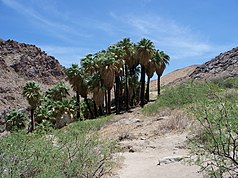Santa Rosa and San Jacinto Mountains National Monument
| Santa Rosa and San Jacinto Mountains National Monument | ||
|---|---|---|
| California Washington Palms in the Santa Rosa Mountains | ||
|
|
||
| Location: | California , United States | |
| Next city: | Palm Springs | |
| Surface: | 1,100.7 km² | |
| Founding: | October 24, 2000 | |
The Santa Rosa and San Jacinto Mountains National Monument is a protected area of the national monument type in the US state of California . It was established by the US Congress in October 2000 to preserve the biodiversity of the mountain range and its cultural significance for the Cahuilla Indians. The area is jointly administered by the Bureau of Land Management , an agency of the US Department of the Interior , and the United States Forest Service , to which the land was federally owned prior to the protection, and the Cahuilla Tribal Council, which owns part of the land.
description
The Santa Rosa and San Jacinto Mountains are the northernmost part of the mountain range that forms the Baja California peninsula in Mexico and extends a good 100 km across the border of the United States. It is called the Peninsular Ranges in English . Its highest point in the reserve is the 3292 m high San Jacinto Peak . In the east lies the Sonoran Desert with the Joshua Tree National Park , in the southeast the Salton Sea . The San Bernardino Mountains join in the northeast, and Los Angeles is just under 100 km to the west .
The area is shaped by the climate of the surrounding deserts. The mountain range is criss-crossed by deep canyons that provide shade and moisture. In them live animal and plant species that are adapted to these environmental conditions. These include the rubber boa , the California gopher tortoise , several species of lizards, and three types of rattlesnakes . Bighorn sheep and coyotes as well as golden eagles live in the reserve . Bald eagles overwinter in the area. In the flora, ferns are particularly notable, which characterize the bottom and the side walls of the canyons.
About 36% of the area of the protected area is subject to further protection as a wilderness area . The Santa Rosa Mountains Wilderness and the Santa Rosa Wilderness are fully integrated into the National Monument and the San Jacinto Wilderness is partially integrated. Over 20% of the National Monument belong to the San Bernardino National Forest , a national forest .
Cultural history
The Santa Rosa and San Jacinto Mountains have been inhabited continuously for at least 3000 years by the ancestors of today's Agua Caliente tribe of the Cahuilla. They lived with families or in small villages that they usually built at the exit of the canyons. Sometimes they had different villages for summer and winter in order to adapt to the climatic conditions.
Petroglyphs , pit houses and foundations of stone structures can be found in the reserve . Several of the mountains are considered sacred to the Cahuilla and are given special consideration in the protection concept.
Santa Rosa and San Jacinto Mountains National Monument today
The protected area is impaired by sharp conflicting goals between the interests of private landowners and beneficiaries and the protection goals. Various privately owned areas are stored in the National Monument, from which disturbances and impairments emanate. The high population density in southern California and the proximity to the metropolis Los Angeles lead to a high level of tourist use, which has a negative impact on nature. The focus is on the area around the mountain station of the Palm Springs Aerial Tramway . In addition, use by mountain bikers and illegal driving on the mountains with off-road vehicles are seen as a threat.
A maintenance and utilization plan had been drawn up by 2002, the measures are largely limited to directing visitors , blocking particularly sensitive or polluted areas, maintaining the hiking trails and archaeological research on Indian settlement in the mountains. In addition, the spread of the tamarisk , a type of shrub that occurs as a neophyte in the area and threatens to displace the native flora and fauna adapted to them and to change the water balance of the area, is being combated .
There has been an information center on the area in Palm Desert since 1996 , which was taken over as a visitor center when the National Monument was founded.
Web links
- Bureau of Land Management: Santa Rosa and San Jacinto Mountains NM (official site) (English)
- US Forest Service: Santa Rosa and San Jacinto Mountains NM (official site) (English)
- Santa Rosa and San Jacinto Mountains NM with the NLCS Coalition , an association of nature conservation organizations.


